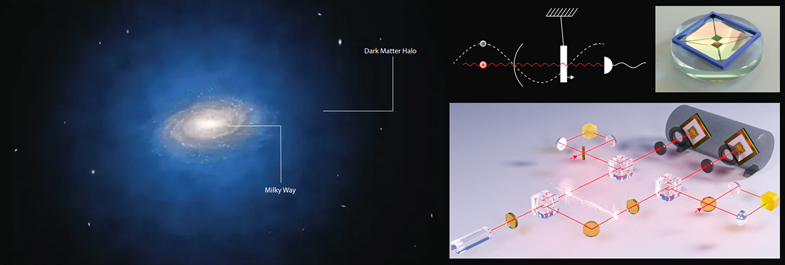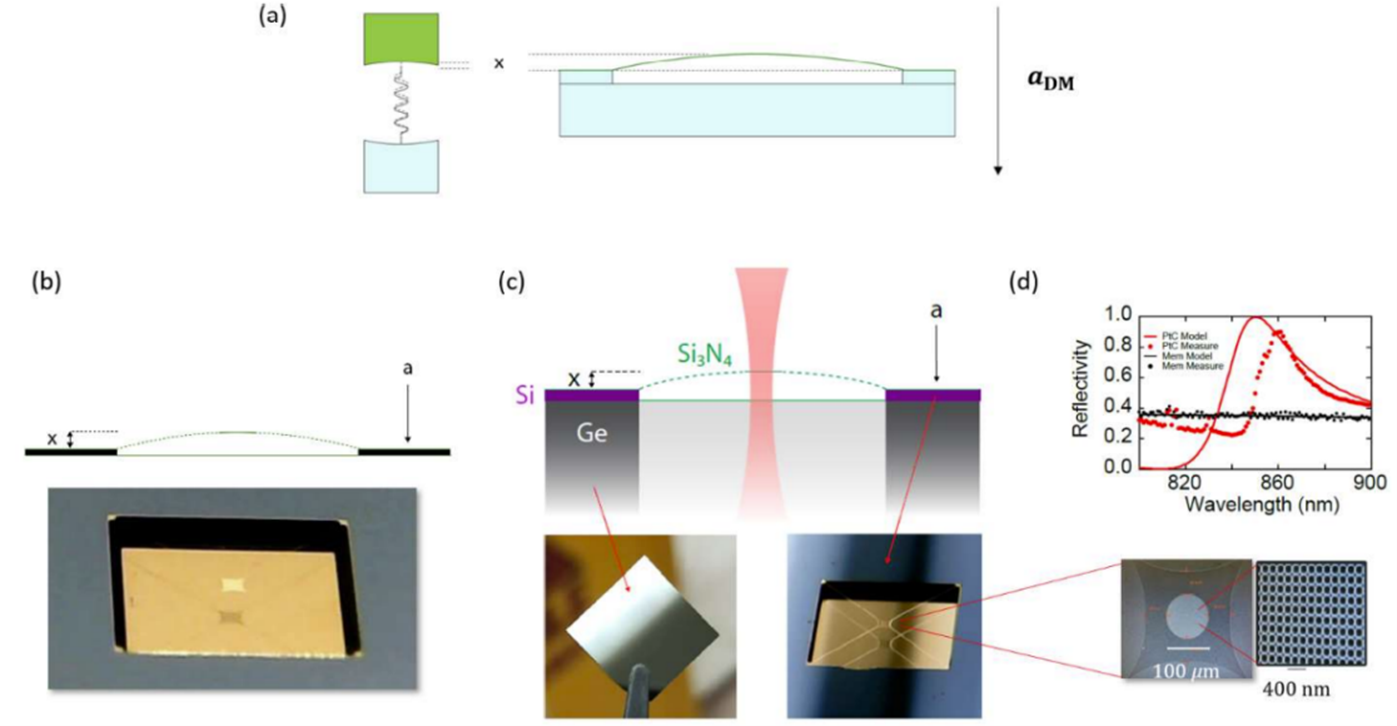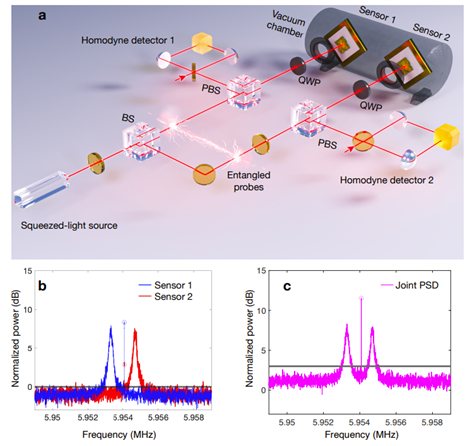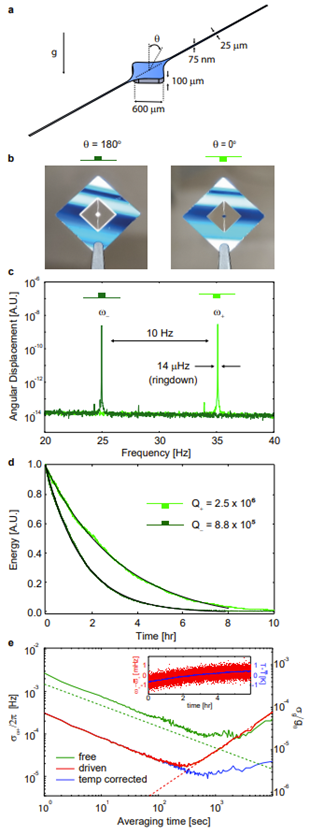Center for Fundamental Physics (CFP)
With Tabletop Experiments
Dalziel Wilson at the University of Arizona
Quantum Optomechanical Dark Matter Detectors (QODM)






The project is to develop a first-generation optomechanical dark matter (DM) detector, leveraging advances in the field of cavity optomechanics that have recently enable force measurements at the quantum limit. The specific dark matter candidate are ultralight vector bosons (dark photons) with Compton frequencies in the 1 kHz – 100 kHz band, corresponding to particle masses between 10−11 eV and 10−9 eV. The detector is based on an ultra-high-Q, cm-scale silicon nitride membrane resonator coupled to an optical cavity made of a neutron dense Beryllium. The use of different materials renders the cavity sen-sitive to force fields proportional to Baryon-Lepton charge, a natural coupling channel for DM – Stand-ard Model (SM) particles.
In addition to first generation detector development, a key aim of the project is to spearhead communi-cation between high-energy, cavity optomechanics, and quantum sensing communities to converge on a longer-range goal of implementing a cryogenic array of optomechanical DM detectors operating at the SQL.
Finally, an implicit goal of the project is to seed opportunities for longer term funding from agencies such as NSF and DOE. As such, the PI planned to spend time reworking/submitting the proposal for larger grant.
The nature of dark matter is one of the enduring scientific mysteries of our time. This project addresses the mystery by exploring a new type of dark matter detector which has the potential to exceed the per-formance of current detectors.
- Mitul Dey Chowdhury – Ph.D. student – salary/tuition (5/21 – 11/22), travel to conferences
- Charles Condos – Ph.D. student – salary/tuition (5/21 – 11/22), travel to conferences
- John (Jack) Manley – Postdoc – salary (8/21 - 12/22)
- John (Jack) Manley – Postdoc – salary (8/21 - 12/22)
- Dalziel Wilson – PI – travel to conferences
A manuscript outlining the project was drafted in parallel with the proposal and published in February 2021:
[1] J. Manley, M.-D. Chowdhury, D. Grin, S. Singh, and D. J. Wilson, “Searching for vector dark matter with an optomechanical accelerometer,” Phys. Rev. Lett., 126 (6), 061301 (2021)
Directly, CFP-Templeton funding was used to support development of a high sensitivity membranebased optomechanical accelerometer (as proposed in [1]) and to design and implement a lowvibration, closed-cycle cryostat for DM experiments. The cryostat (Janis ST-500-UHV RGC4) is current operating in the PI’s lab. The accelerometer platform is reported in a Oct 2022 preprint recently accepted by Phys. Rev. Appl.:
[2] M.-D. Chowdhury, A. R. Agrawal, and D. J. Wilson, “Membrane-based optomechanical acceler-ometry”, arXiv:2208.14984 (2022), provisionally accepted by Phys. Rev. Appl.
Indirectly, support for QODM inspired unexpected and fruitful collaborations between the PI and groups at NIST-Gaithersburg, University of Arizona (now USC and University of Michigan), and Uni-versity of Minnesota, concerning experimental and theoretical implementation of quantumenhanced optomechanical inertial sensing arrays. These include the invention of an ultralow-loss torsion micro-balance with nano-g acceleration sensitivity, the first demonstration of an entanglementenhanced op-tomechanical sensor array, and a theoretical proposal for entanglement-enhance optomechanical DM sensing arrays.
The ultralow-loss torsion microbalance (collaboration with Jon Pratt and Stephan Schlamminger at NIST Gaithersburg) is reported in a Dec. 2021 arxiv preprint recently accepted by Physical Review X:
[3] J. Pratt, A. R. Agrawal, C. A. Condos, C. M. Pluchar, S. Schlamminger, and D. J. Wilson, “Nanoscale torsional dissipation dilution for quantum experiments and precision measurement,” arXiv:2112.08350 (2021), provisionally accepted by —textitPhys. Rev. X
The proof-of-principle demonstration of an entanglement-enhanced OM sensor array (collaboration with Zheshen Zhang at UMich and Quntao Zhuang at USC), deploying an accelerometer similar to that described in [1,2], is reported in a Nov. 2022 arxiv preprint recently submitted to Nature Photonics:
[4] Y. Xia, A. R. Agrawal, C. M. Pluchar, A. J. Brady, Z. Liu, Q. Zhuang, D. J. Wilson, and Z. Zhang et. al., “Entanglement-enhanced optomechanical sensing,” arXiv:2210.16180 (2022), submit-ted to Nat. Phot.
The theoretical proposal for entanglement-enhanced OM dark matter sensing (collaboration with Quntao Zhuang at USC and Zhen Liu at U. Minnesota), which builds on [1] and [4], is reported in a Nov. 2022 arxiv preprint recently submitted to Physical Review Letters:
[5] A. J. Brady, X. Chin, K. Xiao, Y. Xia, Z. Liu, J. Manley, M.-D. Chowdhury R. Harndikd, D. J. Wilson, Z. Zhang, Q. Zhuang et. al., “Entanglement-enhanced optomechanical sensor array for dark matter searches,” arXiv:2210.07291 (2022), submitted to Phys. Rev. Lett.
Finally, with regards to the outreach and funding component of the project, the CFP-Templeton pro-posal was refined over the course of two years (including an initial submission in November 2020 and a resubmission in December 2021) in response to the NSF “Precision Measurement” DCL (NSF PM 20-127). The resubmitted proposal was success, and will allow the project to continue, starting November 2022, under the three year, $450k NSF award #2209473, “Optomechanical Dark Matter Detectors.”
Looking forward, generous supplementary funding from CFP-Templeton has enabled purchase of an entry-level Bluefors dilution refrigerator (LD-4K), a low noise pump laser (Lighthouse Photonics Sprout) for a CW Ti-Sapph laser (Solstis M-Squared, already in the PI’s lab), and startup postdoc salary for Dr. Manley. The laser has arrived and the refrigerator will arrive at the end of December. Funding for Dr. Manley expires Dec 2022 but will be restored, together with Mr. Chowdhury’s and Mr. Condos’s, by the new NSF grant.
Continuing the course set out by [1], our aim in the next 2 years is to functionalize our newly developed membrane-based accelerometer [2] for vector B-L dark matter detection and deploy it the Bluefors fridge operating in closed cycle, at 4 K, with a custom internal vibration isolation system. As shown in the supplementary figures, we are developing a low fidelity detector prototype by placing the accelerometer atop a neutron dense Ge (in lieu of Be) base plate. We target an acceleration sensitivity of 10-11 g/rtHz at 10 kHz, which would allow us to approach leading sensitivity bounds set by Eot-Wash torsion balance experiments.
The name of the paper which we aim to write at the end of the two year period–a long term goal of postdoc Dr. Manley since he started collaborating with my group as a graduate student of Swati Singh’s, at U. Delaware–is “The Invisible Drummer: Searching for Dark Matter with an Optomechanical Membrane.”
In addition to the core research program within the PI’s group (now funded by NSF), collaborations established in the CFP-Templeton phase continue to grow. We anticipate progress in at least two directions:
Torsion microbalance: The torsion microbalance experiment inspired by QODM has an expanded to a collaboration between U. Arizona, NIST-Gaithersburg, and Arizona State University. The latter new collaborator, Assistant Professor William Terrano, is one of the founding proposers of accelerometer-based ultralight DM detection and also a former member of the Eot-Wash group at U. Washington (cur-rently the leading detector for ultralight vector B-L dark matter at our target frequencies). Our team is actively collaborating on a refinement of [3] which explores the ultimate performance of Si3N4-based torsion micropendula as weak force sensors and their application to DM searches and short-range gravity experiments. In service of this collaboration, a partly CFP-funded student, Mr. Condos, was recently employed for 5 months at NIST. The envisioned manuscript’s name is “An ultralow-loss micromechani-cal torsion balance”.
Entanglement-enhanced optomechanical DM sensor arrays: The two recently submitted manuscripts [4,5], drafted during the CFP-Templeton funding period, are expected to be published in the first half of 2023. Collaborating PIs on these two papers: myself (UArizona), Z. Zhang (UMich), Q. Zhuang (USC), and Z. Liu (U. Minnesota) have meanwhile teamed up to draft a LOI for the joint Moore/Sloan/Templeton Small-scale Fundamental Physics Call, entitled “Entanglement-enhanced op-tomechanical dark matter detectors.” This proposal is a more aggressive version of the CFP/NSF QODM proposal which envisions a 10-100 sensor array of OM accelerometers functionalized for ultralight DM detection, collectively enhanced by a distributed squeezed light source. See supplementary figures for details.
[2] M.-D. Chowdhury, A. R. Agrawal, and D. J. Wilson, “Membrane-based optomechanical accelerometry”, arXiv preprint arXiv:2208.14984 (2022), provisionally accepted by Phys. Rev. Appl.
- CFP-Templeton not properly acknowledged in preprint, will amend in Phys. Rev. Appl. proof
*[3] J. Pratt, A. R. Agrawal, C. A. Condos, C. M. Pluchar, S. Schlamminger, and D. J. Wilson, “Nanoscale torsional dissipation dilution for quantum experiments and precision measurement,” arXiv preprint arXiv:2112.08350 (2021), provisionally accepted by Phys. Rev. X
- CFP-Templeton not properly acknowledged in preprint, will amend in Phys. Rev. X proof
*[4] Y. Xia, A. R. Agrawal, C. M. Pluchar, A. J. Brady, Z. Liu, Q. Zhuang, D. J. Wilson, and Z. Zhang et. al., “Entanglement-enhanced optomechanical sensing,” arXiv preprint arXiv:2210.16180 (2022), submitted to Nat. Phot.
- CFP-Templeton not properly acknowledged in preprint, will amend in future proof
[5] A. J. Brady, X. Chin, K. Xiao, Y. Xia, Z. Liu, J. Manley, M.-D. Chowdhury R. Harndikd, D. J. Wilson, Z. Zhang, Q. Zhuang et. al., “Entanglement-enhanced optomechanical sensor array for dark matter searches,” arXiv preprint arXiv:2210.07291 (2022), submitted to Phys. Rev. Lett.
- CFP-Templeton not properly acknowledged in preprint, will amend in future proof
*[6] D. Antypas, et al. ”New Horizons: Scalar and Vector Ultralight Dark Matter.” arXiv preprint arXiv:2203.14915 (2022).
- This is a large consortium white paper and does not include acknowledgements.
[7] J. Manley, M.-D. Chowdhury, C. A. Condos, A. R. Agrawal, C. M. Pluchar, and D. J. Wilson, “The Invisible Drummer: Searching for Dark Matter with an Optomechanical Membrane,” n/a.
*[8] C. A. Condos, A. Agrawal, J. Pratt, C. Pluchar, .J Manley, M.-D. Chowdhury, S. Schlamminger, W. Terrano, and D. J. Wilson, “An ultralow-loss micromechanical torsion balance,” n/a.
© 2018 - Last Updated: 01/31/2023 - Disclaimer
